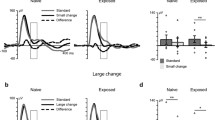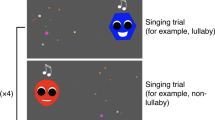Summary
A peptide isolated from rats habituated to a sound stimulus has been given the structure Glu-Ala-Gly-Tyr-Ser-Lys-OH. A synthesis of this compound afforded a product that different from the natural material on the basis of chromatographic and physiological comparisons. The proposed sequence must therefore be in error.
Similar content being viewed by others
Literatur
G. Ungar andS. R. Burzynski, Fedn. Proc.32, 367 (1973), abstract 844.
G. Ungar, personal communication (May 6, 1973).
G. Ungar, Life Sci.14, 595 (1974).—Biochem. Pharmac.23, 1553 (1974).
E. Wünsch andA. Trinkl, Hoppe-Seyler's Z. physiol. Chem.345, 193 (1966).
A. A. Costopanagiotis, B. O. Handford andB. Weinstein, J. org. Chem.33, 1261 (1968).
A. Ali, R. M. Cook andB. Weinstein, Int. J. Prot. Res.4, 177 (1972).
H. Gibian andE. Klieger, Justus Liebigs Annln Chem.640, 145 (1961).
G. Ungar, personal communication (July 16, 1973).
G. Ungar andC. Oceguera-Navarro, Nature207, 301 (1965).
G. Ungar, personal communication (December 3, 1973).
The preparation and biological assay of the synthetic hexapeptide have been briefly described:B. Weinstein andH. N. Guttman, Trans. Am. Soc. Neurochem.5, 173 (1974).
Since the free N6-amino group in lysine will routinely give a positive ninhydrin reaction, then the natural peptide must possess blocking groups at both the glutamic acid and lysine residues.
After this work was completed, a second synthesis appeared:H. Lackner andN. Tiemann, Naturwissenschaften61, 217 (1974). Although the product possessed a broader mp of 170–177°, the chromatographic properties were said to be identical with our peptide. Unfortunately, a direct comparison was not possible between the Seattle and Göttingen peptides, due to a lack of additional material from the latter group. In any event, little biological activity was found and it was concluded that a mistake existed in the original structural investigation.
G. Ungar, personal communication (June 5, 1975). The possible presence of some cofactor has been suggested as an explanation for the higher activity of the natural product.
Author information
Authors and Affiliations
Rights and permissions
About this article
Cite this article
Weinstein, B., Bartschot, R.M., Cook, R.M. et al. The synthesis of a peptide having the structure attributed to a sound habituating material. Experientia 31, 754–756 (1975). https://doi.org/10.1007/BF01938442
Published:
Issue Date:
DOI: https://doi.org/10.1007/BF01938442




